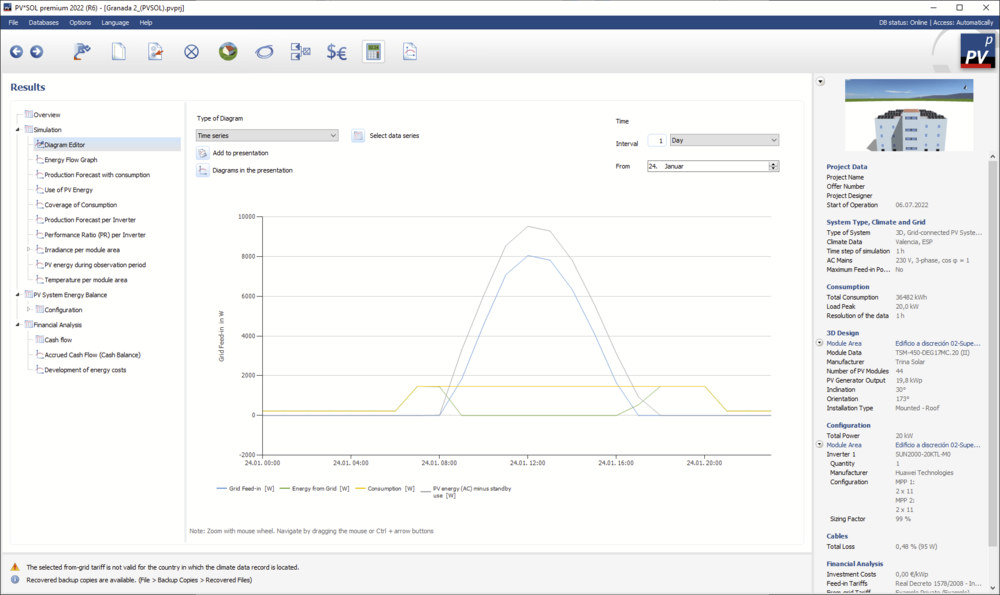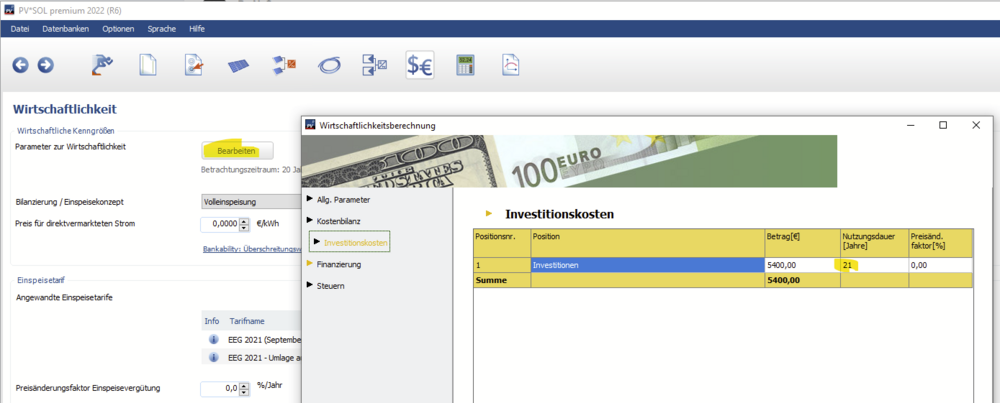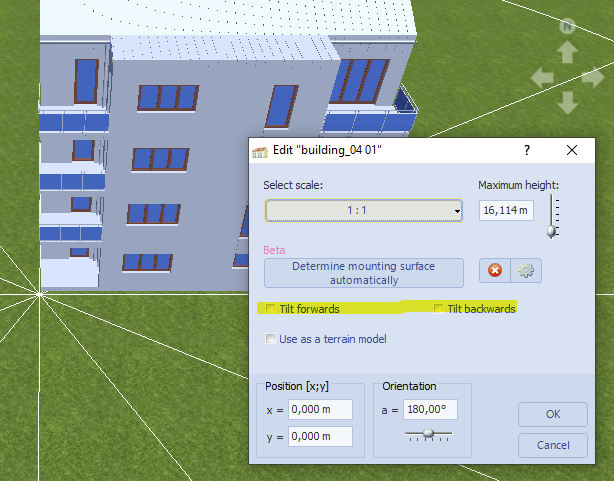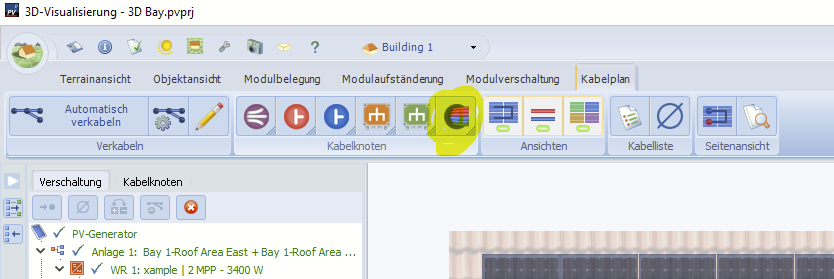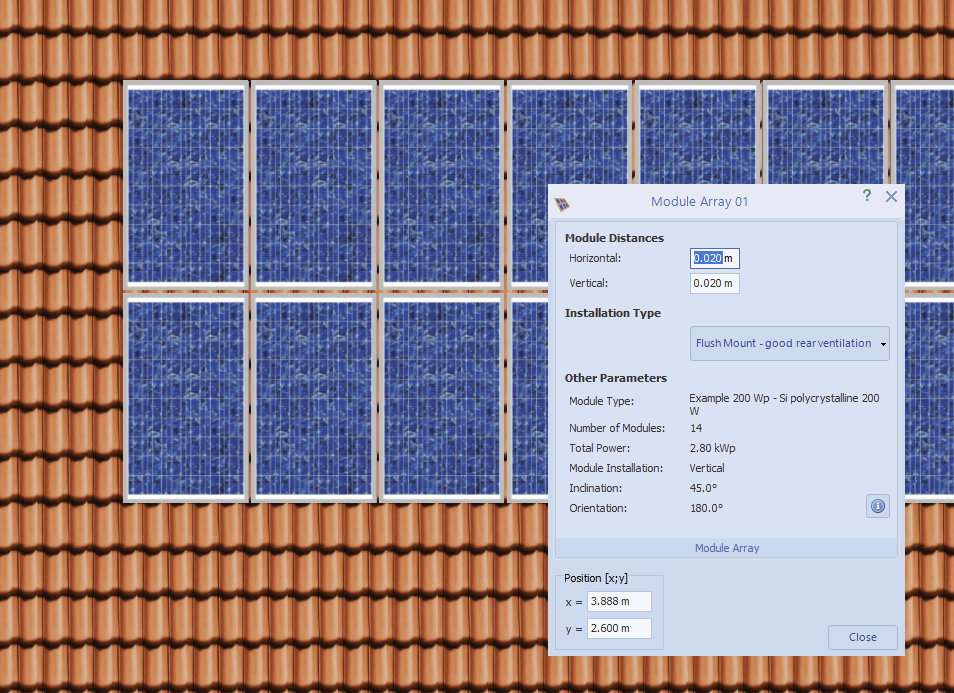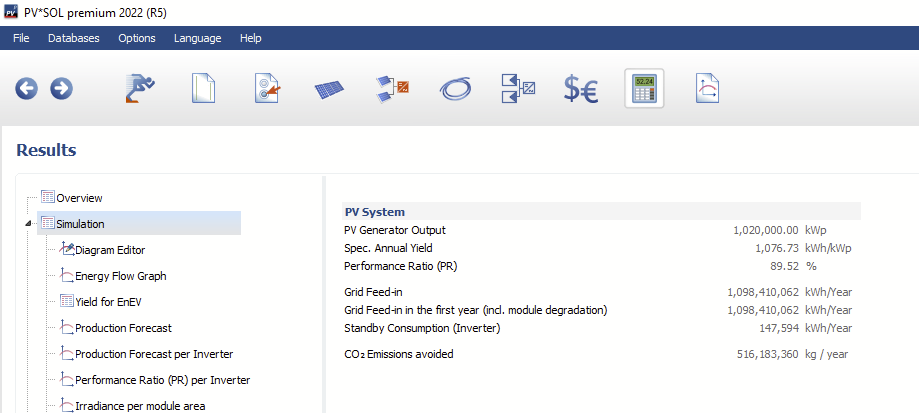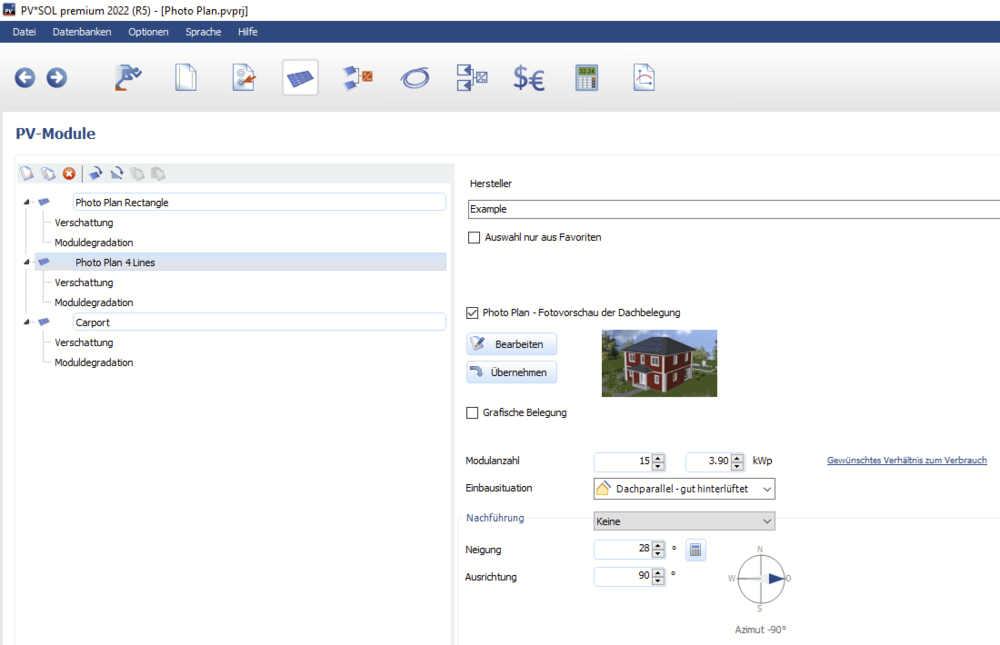-
Posts
1,845 -
Joined
-
Last visited
-
Days Won
172
Everything posted by developer_mh
-
Hi Abdel, did you mean "extrude 3D object"? If so, you have to use the polygon tool without the yellow and black stripes. You seem to have drawn a barred area, as you can see in the tree view on the left. Kind regards, Martin
-
Hallo N_G, ob es irgendwo aggregierte Informationen gibt, weiß ich leider auch nicht. Aber was es auf jeden Fall gibt, sind diverse Anlagen-Monitoring-Portale, die oft auch öffentliche Anlagen umfassen. Hier z.B. das Monitoring einer öffentlichen Anlage aus dem suntrol Portal für das Jahr 2020: https://www.suntrol-portal.com/de/page/hindenlang/year/2020/axis/static/output/real/p/1/chart/default Da gibt es bestimmt ausreichend Referenz-Anlagen, um sich ein Bild zu machen. Viele Grüße, Martin
-
Hallo aqualx, die Prozentzahlen zeigt die Direktabschattungshäufigkeit auf den Modulen. Mehr dazu vielleicht hier: und hier: Zur Frage, warum die zweite Reihe weniger Direktabschattungshäufigkeit aufweist: Spontan würde ich sagen, weil sie nicht in Richtung Haus schaut und daher weniger bzw seltener von ihm abgeschattet wird. Man kann sich das ganz gut anschauen, wenn man sich in 3D den Verlauf der Schatten anschaut. Dazu gibt es das kleine Sonnenstandstool. Beste Grüße, Martin
-
Hi solar_dk, the Tauro Eco 50-3-P only has one MPP tracker, see here as well: https://www.fronius.com/en/solar-energy/installers-partners/technical-data/all-products/inverters/fronius-tauro-eco/tauro-eco-50-3-p Kind regards, Martin
-
Dear Kjetil, perhaps this thread might shed some light in how we calculate what in terms of IRR, ROA and NPV: Hope that helps, kind regards, Martin
-
Hallo Ferfried, danke für den Input. Das ist in der Tat komplizierter als es sein müsste. Wir haben diesen Wunsch auch schon auf der Liste, derzeit kann ich aber noch nicht sagen, wann wir uns daran machen können. Viele Grüße, Martin
-

Limiting the percentage of Grid feed-in
developer_mh replied to Sun Power Spain 365's topic in PV*SOL
Hi again, and thanks for the project file. You can use the diagram editor in order to see when the grid feed-in occurs. In the months between January and June, and between October and December, the consumption is so low that during the day there's always PV energy excess that is fed into the grid: In the hours of the early morning and late evening there is not enough PV power to cover the load, so it must be drawn from the grid. If the load profile is close to what you expect in the real building, there is no way to avoid the grid feed-in. There will always be moments where the PV power is higher than the load. You can, however, set the maximum feed-in power clipping to 0%. In that case, the inverters will regulate down if the energy is not needed. Kind regards, Martin -

Limiting the percentage of Grid feed-in
developer_mh replied to Sun Power Spain 365's topic in PV*SOL
Hi Sun Power Spain 365, in order to give you a more detailed answer, would it be possible for you to send me the project file? You can send it here in the forum as attachment on a private message to me. Thanks in advance, kind regards, Martin -

Limiting the percentage of Grid feed-in
developer_mh replied to Sun Power Spain 365's topic in PV*SOL
Dear Sun Power Spain 365, it is correct that the own power consumption depends strongly on the concurrency of available PV power and the power demanded by the electric appliances. If in any hour of the year the generated PV power is higher than the demand of the electric appliances, the exceeding energy will be fed into the grid. Where else should it go? If the generated PV power is lower than the demand of the electric appliances, the missing portion of the power demand must be taken from the grid. Only if the PV power is equal to the power demand of the electric appliances at any time of the year (in all 8760 hours of the year if you simulate in one-hour steps), then the own power consumption will be 100%. It will not be possible to reduce the grid feed in to 0 kWh per year, or even near that, if you have a reasonably sized PV system and a normal load profile. You are also possibly confusing the own power consumption ratio (how much of my generated PV energy can I use?) with the solar fraction (how much of my electrical energy demand can be covered by the PV system?). These are two different numbers and mean different things. In standard cases (reasonably sized PV system and standard load profile of household or industry) you can expect around 30% of own power consumption and perhaps around 50% of solar fraction. These values change dramatically with the size of the PV system and the load profile, but a 95% to 100% own power consumption is nothing you will see in real life, except for when your PV system is very small in comparison to your energy demand. Hope that helps, kind regards, Martin -
Dear Go Green BG, thanks for your question. On your screenshots everything looks fine. Also, a performance ratio of 86% is quite good. What do you mean when you want to "increase efficiency"? Do you mean the nominal efficiency of the PV module? In case you want to dive deeper into the calculation and the meaning of the performance ratio, this link might help: Kind regards, Martin
-
Hallo N_G, ja, das ist möglich. Dazu muss man in den Parametern zur Wirtschaftlichkeit in der Kostenbilanz bei den Investitionen auf "detaillierte Eingabe" gehen. Dann gibt es eine tabellarische Eingabemaske, in der man auch die Nutzungsdauer einer Investition eingeben kann: Dort können dann beliebige Postitionen mit unterschiedlichen Nutzungsdauern angelegt werden. Beste Grüße, Martin
-
Dear juhaina, this looks like a problem with the 3D model that you are using. Also be sure to use the most recent version of PV*SOL, since we published a important fix for the calculcation of the shadow frequency with PV*SOL premium 2022 R5. Kind regards, Martin
-
Hallo Hendrik, das Kippen geht, indem man mit Rechtsklick auf das importierte Modell geht, Bearbeiten wählt und dann die entsprechenden Häkchen setzt: Wenn man in diesem Dialog auf das Zahnrädchen klickt, kommt man auch in den Optionen-Dialog, in dem man noch die Option zur Reduktion der Punkte setzen kann. Das ist vor allen Dingen bei großen Objekten für die Performance der Schattenberechnung interessant. Ansonsten kann ich leider zu pix4d oder anderen 3D-Programmen keine ausgereiften Tipps und Tricks zur Punktreduzierung geben. Aber da finden sich bestimmt Anleitungen im Netz. Beste Grüße, Martin
-
Hi anees, you can send an email with your customer number and your serial number to sales@valentin-software.com. They can deactivate the licence, so that you can activate it again on your freshly installed system. Kind regards, Martin
-
Dear leojan, this kind of information is not available in PV*SOL, and it can't be. I'd guess that you as a PV system vendor/installer would have to develop a suitable PR warranty yourself. What PR can you guarantee to your customer? A warranty like that would be mostly based on the PV module performance guarantee (which the manufacturer is providing, like 90% of the original output power over 20 years or so), and some kind of service agreement with respect to the functionality of the inverters and so on. Kind regards, Martin
-
Hallo Hendrik, bei den Drohnenmodellen ist es in der Tat wichtig, dass sie nicht zu viele Punkte enthalten. In pix4d gibt es meines Wissens eine Funktion, mit der man die Punkte reduzieren kann. Oder evtl. mal Blender ausprobieren. Vielleicht gibt es in diesem Video auch noch wertvolle Hinweise: Das Drehen des Objekts kann während des Imports erfolgen, da gibt es im entsprechenden Dialog Möglichkeiten, das Modell nach vorne oder hinten zu kippen. Beste Grüße, Martin
-

Automatische Verkabelung beim 3D Modell - Kabeldurchführung wo?
developer_mh replied to Ifrit's topic in PV*SOL
-
Hallo Ifrit, freut mich, dass es geklappt hat! Wenn noch Fragen auftauchen, gerne fragen Beste Grüße, Martin
-

[Request] Updated climate data for pre-selected locations
developer_mh replied to Jimmy's topic in PV*SOL
Hi Jimmy, thanks for the feature request, sounds good! We will put it on the list. Kind regards, Martin -
Hi James, yes, this is fixed in the upcoming release PV*SOL premium 2022 R5. We are very sorry for the unconvenience caused. Kind regards, Martin
-
Hi Ludd, there is no automatic function to do this, I am afraid. You can enter the exact position, though. With a little math (x = (length of roof - length of module array)/2) you can determine the x value needed to center the modules. Hope that helps, kind regards, Martin
-

Photovoltaikanlage + Batterie in Verbindung mit einer Wärmepumpe
developer_mh replied to Marco EL's topic in PV*SOL
Hallo Marco, man kann derzeit in PV*SOL nur PV mit Batteriesystemen oder PV mit einem thermischen System simulieren. Eine Möglichkeit ist aber, den elektrischen Verbrauch der Wärmepumpe als "normalen" elektrischen Verbraucher in einem System mit PV und Batterie zu hinterlegen. Dann kann man alle drei Elemente miteinander simulieren. Allerdings ist das Energiemanagement dann natürlich nicht besonders intelligent. Der elektrische Verbrauch wird ja immer vorrangig bedient. Genau das Energiemanagement, das die Energieflüsse zwischen Batteriesystem, Wärmepumpe und gegebenenfalls Elektro-Auto leitet, ist bisher nicht implementiert. Daher können wir diese Option bisher nicht in PV*SOL anbieten. Nein, GeoT*SOL ist ein reines Wärmepumpen-Programm. Man kann hiermit aber sehr schön realistische elektrische Wärmepumpenprofile erzeugen, die man dann in PV*SOL importieren kann. GeoT*SOL kann aber keine PV und keine Batteriesysteme. Hoffe, das hilft weiter. Beste Grüße, Martin -
Here is a small screenshot of PV*SOL showing results for a 1 GWp PV system (simulation duration on my computer was < 1 min).
-
Dear Davidvc, the only restriction we have in PV*SOL is the number of modules and mounting systems used in the 3D environment. If you plan without 3D, the PV plant size is unlimited. If you plan in 3D, we restrict the maximum module number to 10000 (or 7500 for mounting systems). If you multiply that by the current nominal power of a typical module, say 350 Wp, you get 3.5 MWp as a limit. The threshold is editable in the settings file, though. It really depends on your computer.. Without 3D planning, you can easily simulate more than 500 MWp. Kind regards, Martin
-
Hallo Mats, das geht, indem man pro Dachfläche eine Modulfläche anlegt. In der Beispiel-Datei "photoplan" ist das so gemacht: Beste Grüße, Martin


